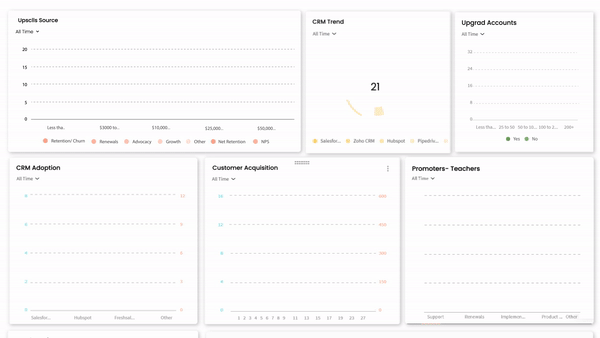Survey & Feedback
Defining Survey Goals and Objectives: A Quick Guide
Article written by Pragadeesh Natarajan
pragadeesh
9 min read
19 September 2025

Survey goals and objectives are important because they help you ask the right questions, obtain useful answers, and achieve the best results.
How do we know?
Because setting goals and objectives is the first step in our template creation process, and we’ve experienced all of those benefits firsthand.
In this article, we’ll:
- Know the difference between survey goals and survey objectives.
- Dig deeper into why survey goals and objectives are so important.
- Show you how to set goals and objectives for your surveys.
- Talk about a few survey goal examples.
- Explore a few best practices you can follow to define specific objectives.
Ready? Let’s get started. You can click to jump ahead to the section that interests you.
What’s a Survey Goal? What are the Survey Objectives?
Your goal is the primary aim of your survey. It’s a broad statement that explains the purpose of your survey and what you’re looking to achieve with it.
You need answers from a group of people, and your goal conveys why you need to get those answers from this group of people.
An objective is a specific step or action that would help you achieve your survey’s goal. Often, there will be multiple objectives for a single goal statement.
For instance:
Goal: “To understand why our customers churn”.
- Objective 1: “To assess various factors that lead to cancellation such as bugs, competitors, performance, pricing, support, etc.”
- Objective 2: “To determine the percentage of customers that stopped using our product within the last 6 months.”
The Importance of Survey Goals and Objectives
Why should you begin by setting a goal for your survey? Why not jump head-first into asking a bunch of questions?
Before you can ask questions, you need to know how you’d use the answers. How are you going to put the data to use?
The answers you gain from your survey are only useful if you have a clear idea about how you’d use them and the actions and decisions you’d take with them.
A survey goal explains the purpose of collecting the data through your survey. Once you know the goal you want to accomplish with your survey, you get a clear idea about what you want to learn. And when you’re clear about what you want to learn, it gets a lot easier to come up with the right questions you’d want to ask your audience.
When the survey’s purpose is clear, you’ll:
- Know the right type of questions to ask
- Get rid of the ambiguous questions
- Stick to only the questions that’ll help you reach your goal
- Include questions that are highly relevant to your goal
As you can see, setting goals and objectives is the essential first step in conducting a successful survey.
The second step is choosing the right survey software, because you will get access to 1000+ survey templates for different survey goals, like market research, bestselling products, website usability, etc.
Here’s a quick survey created using SurveySparrow.
You can create a free account to get 14-day unrestricted access to our enterprise survey software.
To create such surveys, sign up for FREE here.
14-day free trial • Cancel Anytime • No Credit Card Required • No Strings Attached
How to Set Goals and Objectives for Your Survey
Setting goals and objectives can be quite confusing. Here are a few questions you can ask yourself to define goals and objectives for your surveys:
What is the Subject or Topic?
What is it that you need feedback or opinion about?
For instance, the subject or topic could be an experience — say, your users’ onboarding or purchase experience — your product or service, a functionality, your brand, an event, etc.
What Do I Want to Learn?
Now that you’ve nailed the subject of your survey, you need to know what you want to learn about the subject. Ask yourself: what am I looking to learn?
For instance, you might want to learn about your customers’ satisfaction with your product, or you might be looking to determine the effectiveness of your landing page copy.
Who Should I Ask?
Once you’re clear about the subject and what you’re looking to learn about it, the next step is to identify who you’re looking to learn that from.
Think about the target audience you’d be reaching out to for opinions about the subject. The people you need answers from. The people who’d provide you with the right set of answers.
The key is to narrow down on a specific customer segment that would provide you with accurate information.
What Do I Intend to Accomplish with the Data I Collect?
What are you looking to achieve with the answers that have been provided to you? How would it lead to you improving, understanding, or determining something?
For instance, you might want to validate if there’s a need for a solution because you’re looking to solve an unmet need and develop a better offering for a specific customer segment.

If you’re finding it hard to develop goals and objectives for your surveys, you can follow a simple framework to write effective goal statements.
A. Start your objective or goal statement with the word to, followed by an action verb such as improve, measure, assess, validate, investigate, explain, explore, identify, and so on.
For instance, “To determine how satisfied customers are with a new functionality”, “To identify what motivates our ideal customers to choose us over our competitors”, “To inform us on how many items we need to procure this quarter”, etc.
B. You can then come up with relevant objectives based on your goal statement. Once you have the objectives required to attain the survey’s goal, you can put together a list of questions needed to achieve those objectives.
What are Some Common Survey Goals and Objectives?
Now that you know what survey goals and objectives are and how you can define them, let’s take a look at some common survey goal examples you can take inspiration from to define your own.
Survey Goal Examples
- The typical customer service survey goals:
- Identify the customers dissatisfied with our service and resolve their issues.
- Explore opportunities to provide better support.
- Understand how a specific interaction affected the relationship.
2. The common employee survey goals:
- Measure the overall engagement and satisfaction of all employees.
- Determine employees’ understanding of our company’s mission and values.
- Measure the success of our current policies and procedures.
- Understand the key drivers of team effectiveness and performance.
3. A business executive looking for feedback regarding:
- a product or functionality
- an experience
- a service
- or a recent event
4. A startup or an SMB owner looking to understand:
- the size of the addressable market
- the buyer personas or customer profiles
- the target segment’s brand preferences
- the direct or indirect competitors
- unmet or underserved customer needs
Setting Survey Objectives: 3 Best Practices
Objectives help you ask the right questions, get the correct answers, and make the survey process so much easier. Here are a few best practices you can follow to define clear objectives for your survey:
1. Define SMART Objectives
Your survey objectives should follow the specific, measurable, achievable, relevant, and time-bound (SMART) rule.
- Specific: Your objective needs to be precise and lay out the exact step or action needed to achieve your survey’s goal.
- Measurable: Rather than stating “to increase customer retention”, you could say something along the lines of “to increase customer retention by 5%”.
- Achievable: Increasing your customer satisfaction from 60% to 90% is much less achievable than increasing it from 60% to 70%.
- Relevant: Is the objective relevant to the overall goal of your survey?
- Time-bound: You make your objective time-bound when you say “to increase customer retention by 5% in 3 months”.
2. Research on the Subject (or Topic)
You need to conduct thorough research on the subject of your survey. When you have a firm grasp of the survey’s subject, you can write insightful questions that help you achieve your survey’s goal. For instance, if you’re a marketing manager, and you’re looking to conduct a survey, the subject of your survey could be:
- Messaging, positioning, and brand perception
- New product feature
- Brand assets, logo, and design
- Product satisfaction
- Ad concepts
- PR
That said, keep in mind that most information is inherently biased and not trustworthy.
3. Get Feedback
Once you’re done writing the goals and objectives for your survey, review them a few times. Make sure everything is clean and organized.
After you’ve reviewed it for flaws, ask a colleague to critique it. They can provide you valuable feedback on how you can improve them and help you spot any holes or mistakes that you might have missed.
Also, before you start distributing your survey, run a survey pilot. Select a small group of respondents from your target group and ask them for their feedback and ideas. Doing this will help you identify any issues or vague questions in your survey.
Final Thoughts
Before you can write your questions and gain insights, you need to be clear about why you need to gain those insights.
When you’ve defined clear goals and objectives, you make sure that the data you collect is worthwhile, valid, and accurate.
Got any questions on setting survey goals and objectives? Any interesting tips or techniques you use to define clear goals and objectives for your surveys? Let us know about them in the comment section below.
Looking to create conversational surveys that people love answering? Feel free to check out SurveySparrow.

Create engaging surveys that people actually complete. Try SurveySparrow now!
Pragadeesh Natarajan
I'm a developer turned marketer, working as a Product Marketer at SurveySparrow — A survey tool that lets anyone create beautiful, conversational surveys people love to answer.
Related Articles

Survey & Feedback
The ultimate 7 tips for getting more respondents for your survey
4 MINUTES
11 August 2019

Survey & Feedback
SurveyMonkey vs Google Forms — Which is Best in 2024?
18 MINUTES
23 May 2022

Survey & Feedback
How to Craft Effective Coaching Effectiveness Survey Questions
12 MINUTES
17 June 2023

Survey & Feedback
How AI Integrations in Surveys Can Boost CX
11 MINUTES
3 July 2023
